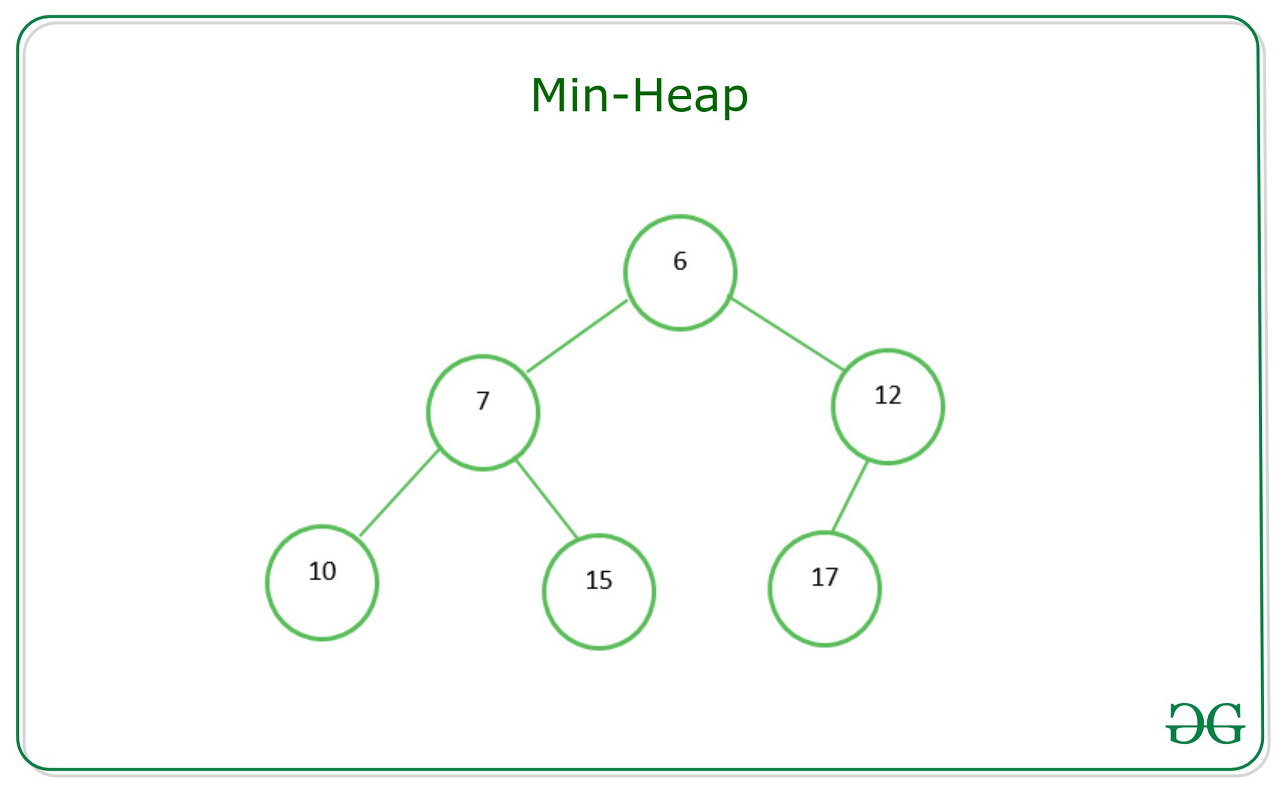우선순위 큐란?
- 일반적인 큐는 선입선출 (FIFO)원칙에 따라 데이터가 처리된다.
- 우선순위 큐는 각 데이터들이 우선순위가 있어서, 큐에 들어온 순서는 차순위가 되고 정해진 우선순위에 따라 데이터가 큐에서 나가게 된다.
Heap 자료구조
- Heap 자료구조는 완전 이진트리의 일종이다.
- 완전이진트리란 루트 노드부터 시작하여 왼쪽 자식, 오른쪽 자식 순서대로 데이터가 삽입되는 트리를 말한다.
- Heap은 항상 루트 노드를 제거하는 식으로 동작한다.
- 자바스크립트로 우선순위 큐를 구현하는데 있어서 이 Min Heap (최소 힙) 자료구조를 사용한다.
- 최소 힙은 부모 노드가 항상 자식 노드보다 값이 작다는 특징을 갖고 있다.

일반 배열을 사용하지 않는 이유는 무엇일까?
- 데이터를 조회하기 위해 배열을 순회하게 되면 O(n)의 시간 복잡도가 걸린다.
- 힙을 사용하게 되면 O(1)의 시간복잡도까지 낮출 수 있다.
- 자료를 추가로 삽입하거나 삭제하는 경우에도 O(logn)의 시간복잡도로, 굉장히 높은 효율성을 가진다.
최소 힙 기반의 우선순위 큐를 직접 구현해보자.
2차원 트리를 선형적인 배열로 구현할 수 있다.
class PriorityQueue {
constructor() {
this.heap = [];
}
}생성자 함수로는 우선 빈 배열을 만든다.
size() {
return this.heap.length
}
isEmpty() {
return this.heap.length === 0
}우선순위 큐의 사이즈와 비어있는지 여부를 확인하는 메서드들을 추가한다.
데이터 삽입 기능을 구현해보자
enqueue(value) {
this.heap.push(value);
this.heapifyUp();
}
enqueue라는 메서드를 추가하여 힙 배열에 추가하려는 값을 push하였다.
이후 최소 힙 원칙에 따라 정렬하는 heapifyUp메서드를 실행한다.
heapifyUp 메서드에 대한 상세 구현은 아래에서 살펴보자.
heapifyUp() {
let i = this.size() - 1;
const lastNode = this.heap[i];
while (i > 0) {
const parentIndex = Math.floor((i - 1) / 2);
if (this.heap[parentIndex] > lastNode) {
this.heap[i] = this.heap[parentIndex];
i = parentIndex;
} else {
break;
}
}
this.heap[i] = lastNode;
}부모노드의 인덱스를 계산하여 크기 비교를 하고, 더 작다면 위치를 바꿔주는 반복문을 통해 맨끝에 새로 삽입된 노드를 정렬해주는 코드이다.
삽입을 구현했으니, 노드를 삭제하는 것도 구현해보자.
dequeue() {
if (this.isEmpty()) return null;
const rootNode = this.heap[0];
const lastNode = this.heap.pop();
this.heap[0] = lastNode;
this.heapifyDown();
return rootNode;
}앞서 말했다시피 힙에서의 삭제는 항상 루트노드에서만 일어난다. 루트 노드 자리를 제일 마지막 노드로 가져오고 heapifyDown 메서드로 정렬해주면 자연스레 기존의 루트 노드는 참조를 잃고 큐에서 사라지게 된다.
heapifyDown() {
let i = 0;
const rootNode = this.heap[i];
const heapSize = this.size();
let swapIndex;
while (true){
let leftChildIndex = i * 2 + 1;
let rightChildIndex = (i * 2) + 2;
if (leftChildIndex < heapSize) {
if (this.heap[leftChildIndex] < this.heap[i]) {
swapIndex = leftChildIndex
}
}
if (rightChildIndex < heapSize) {
f (
(swapIndex === null && this.heap[rightChildIndex] < this.heap[i]) ||
(swapIndex !== null && this.heap[rightChildIndex] < this.heap[leftChildIndex])
) {
swapIndex = rightChildIndex;
}
}
if (swapIndex === null) break;
[this.heap[i], this.heap[swapIndex]] = [this.heap[swapIndex], this.heap[i]];
i = swapIndex;
}
}heapifyDown은 상위 루트노드를 좌우의 자식노드와 비교하여 트리의 하위로 점점 내리면서 정렬시키는 메서드이다. 왼쪽 자식과 오른쪽 자식 중 바꾸어야할 인덱스를 swapIndex로 지정하여 노드 위치를 교환한다.
전체 코드
전체 코드는 다음과 같다.
class PriorityQueue {
constructor() {
this.heap = [];
}
size() {
return this.heap.length
}
isEmpty() {
return this.heap.length === 0
}
heapifyUp() {
let i = this.size() - 1;
const lastNode = this.heap[i];
while(i > 0) {
const parentIndex = Math.floor((i - 1) / 2);
if (this.heap[parentIndex] > lastNode) {
this.heap[i] = this.heap[parentIndex];
i = parentIndex;
} else {
break;
}
}
this.heap[i] = lastNode
}
enqueue(value) {
this.heap.push(value);
this.heapifyUp();
}
dequeue() {
if (this.isEmpty()) return null;
const rootNode = this.heap[0];
const lastNode = this.heap.pop();
this.heap[0] = lastNode;
this.heapifyDown();
return rootNode;
}
heapifyDown() {
let i = 0;
const rootNode = this.heap[i];
const heapSize = this.size();
let swapIndex;
while(i > 0) {
let leftChildIndex = i * 2 + 1;
let rightChildIndex = (i * 2) + 2;
// 왼쪽 자식 인덱스가 범위 안에 있고,
if (leftChildIndex < heapSize) {
// 대상이 왼쪽 자식보다 크다면, 왼쪽 자식 인덱스를 바꿔야할 인덱스로 지정
if (this.heap[leftChildIndex] < this.heap[i]) {
swapIndex = leftChildIndex
}
}
// 오른쪽 자식 인덱스가 범위 안에 있고,
if (rightChildIndex < heapSize) {
if (
// 바꿔야할 인덱스가 지정된 값이 없고, 대상이 오른쪽 자식보다 크거나
(swapIndex === null && this.heap[rightChildIndex] < this.heap[i]) ||
// 바꿔야할 인덱스가 왼쪽으로 지정되어 있지만, 왼쪽 자식이 오른쪽 자식보다 크다면
(swapIndex !== null && this.heap[rightChildIndex] < this.heap[leftChildIndex])
) {
// 바꿔야할 인덱스로 오른쪽 자식 인덱스를 지정한다.
swapIndex = rightChildIndex;
}
}
// 바꿔야할 인덱스가 없다면 반복문 종료
if (swapIndex === null) break;
// 바꿔야할 인덱스와 대상의 위치를 바꿔준다.
[this.heap[i], this.heap[swapIndex]] = [this.heap[swapIndex], this.heap[i]];
i = swapIndex;
}
}
}글을 쓰는데 도움이 된 자료들
JavaScript로 Heap | Priority Queue 구현하기
그래프 자료구조에서 엣지 간에 최단거리를 구하는 다익스트라 알고리즘(Dijkstra Algorithm)을 사용해서 문제 해결을 하려고 했더니, 우선순위 큐에 대한 이해가 부족해서 이 글을 쓰게 되었다.
jun-choi-4928.medium.com
https://stackoverflow.com/questions/42919469/efficient-way-to-implement-priority-queue-in-javascript
Efficient way to implement Priority Queue in Javascript?
Priority Queues have a priority value and data, for every entry. Thus, when adding a new element to the queue, it bubbles up to the surface if it has a higher priority value than elements already ...
stackoverflow.com
'Computer Science' 카테고리의 다른 글
| [CS] REST API의 Code On Demand 원칙이 필수가 아닌 이유는 무엇일까? (0) | 2024.01.12 |
|---|---|
| 세션과 토큰 (0) | 2023.10.16 |
| [알고리즘] 최적 부분 구조 (0) | 2023.06.25 |